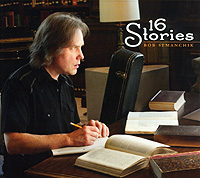 In my liner notes for 16 Stories—the 2011 CD release
from CT-based singer-songwriter Bob Semanchik, I compared
some of Bob’s latest work to pop-rock giants like Sting and Paul
McCartney. Also noticeable on Bob's new CD is a Peter Frampton influence,
although 16 Stories is by no means a Brit-pop type album. Instead,
Semanchik creates intimate sounding pop vignettes that transcend time
and musical fads. In this setting, Semanchik’s songs are truly
timeless—the mark of a great song being one that could have been
created 40 or 60 years ago. Bob turned heads around with his solo
debut from 2009, Standard Interpretations—an album that
featured several vocals mixed in with the jazzy guitar based instrumental
style that Semanchik is renowned for. Among the instrumentals covered
on that ‘09 album are Semanchik covers of Jobim, Brubeck and
McCartney, yet on 16 Stories, Semanchik exposes a side of him
that not too many music fans have yet heard—that of a first rate
pop-rock singer-songwriter with a unique vocal approach. Anyone fearing
that Bob’s emphasis is now solely on singing his songs need not
worry—Bob's electric and acoustic guitar playing is right there
on most tracks with several featuring stinging guitar solos that would
even impress fans of Beatles’
In my liner notes for 16 Stories—the 2011 CD release
from CT-based singer-songwriter Bob Semanchik, I compared
some of Bob’s latest work to pop-rock giants like Sting and Paul
McCartney. Also noticeable on Bob's new CD is a Peter Frampton influence,
although 16 Stories is by no means a Brit-pop type album. Instead,
Semanchik creates intimate sounding pop vignettes that transcend time
and musical fads. In this setting, Semanchik’s songs are truly
timeless—the mark of a great song being one that could have been
created 40 or 60 years ago. Bob turned heads around with his solo
debut from 2009, Standard Interpretations—an album that
featured several vocals mixed in with the jazzy guitar based instrumental
style that Semanchik is renowned for. Among the instrumentals covered
on that ‘09 album are Semanchik covers of Jobim, Brubeck and
McCartney, yet on 16 Stories, Semanchik exposes a side of him
that not too many music fans have yet heard—that of a first rate
pop-rock singer-songwriter with a unique vocal approach. Anyone fearing
that Bob’s emphasis is now solely on singing his songs need not
worry—Bob's electric and acoustic guitar playing is right there
on most tracks with several featuring stinging guitar solos that would
even impress fans of Beatles’  McCartney
and Harrison. In contrast to several of the tracks here that veer
into light hearted ballads, most of the tracks here really sizzle
and there’s also plenty of songs that one might consider singles
material, including the McCartney-esque “It’s In The Way,”
the rock conscious guitar textured “Goodbye” and what might
be the most powerful and immediate song here called “The Power
Of Love.” Other songs on 16 Stories—a good example
being the CD closing “Hope”—start off slow, yet are
built up with a combination of orchestral, melodic cadences and tastefully
layered electric guitars. With Semanchik handling most of the instruments,
he receives solid support from drummer Mike Marble and a pair
of bass players in album co-producer Paul Opalach and Chris
Reba. Melodic rock, pop, jazz and more are all sounds and styles
in play on Bob Semanchik’s 16 Stories. www.bobguitar.com
McCartney
and Harrison. In contrast to several of the tracks here that veer
into light hearted ballads, most of the tracks here really sizzle
and there’s also plenty of songs that one might consider singles
material, including the McCartney-esque “It’s In The Way,”
the rock conscious guitar textured “Goodbye” and what might
be the most powerful and immediate song here called “The Power
Of Love.” Other songs on 16 Stories—a good example
being the CD closing “Hope”—start off slow, yet are
built up with a combination of orchestral, melodic cadences and tastefully
layered electric guitars. With Semanchik handling most of the instruments,
he receives solid support from drummer Mike Marble and a pair
of bass players in album co-producer Paul Opalach and Chris
Reba. Melodic rock, pop, jazz and more are all sounds and styles
in play on Bob Semanchik’s 16 Stories. www.bobguitar.com
mwe3.com presents an interview
with BOB SEMANCHIK
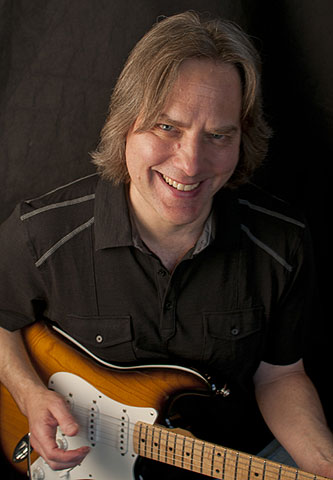 mwe3:
It seems like on 16 Stories you went for a more pop-conscious
recording approach. How would you compare the sound and scope of 16
Stories with your Standard Interpretations solo album from
2009?
mwe3:
It seems like on 16 Stories you went for a more pop-conscious
recording approach. How would you compare the sound and scope of 16
Stories with your Standard Interpretations solo album from
2009?
Bob Semanchik: For 16 Stories I was definitely thinking
pop, but what you hear is just what comes to me naturally. I think
there is a lot of similarity between this CD and the sounds on Standard
Interpretations in the guitar texture department but the difference
being 16 Stories is an original vocal project. With this project
I feel much more of what I am as a person and musician comes across
not just as a guitar player but lyrically as well.
My original plan for Standard Interpretations was to keep the
recordings somewhat sparse with limited overdubs as most of the initial
tracks were recorded as one performance like a jazz album would be
done. When I brought everything back to my home studio I felt that
it would be more interesting to the listener if the tracks had different
textures. So I ended up using a pop approach to the tracks with overdubs.
I had so much fun doing this that I couldn’t wait to do this
with my own material. Sonically, the addition of Paul Opalach’s
help in the early tracking stages and Mike Marble’s drumming
would be the biggest difference, also the fact that my songs are all
vocally orientated led me down a different sonic path.
mwe3: Where and when was 16 Stories recorded and who produced
and recorded with you on the new album? Are there some cuts where
you play everything and what is performing every instrument like for
a recording artist?
BS: The drums were played by Mike Marble and recorded in Shelton,
Ct. at Long Hill Recording. This is where some hand percussion and
a couple vocal parts were recorded as well. Paul Opalach who runs
the studio, also added bass parts to four tracks there. I recorded
everything else at my home studio.
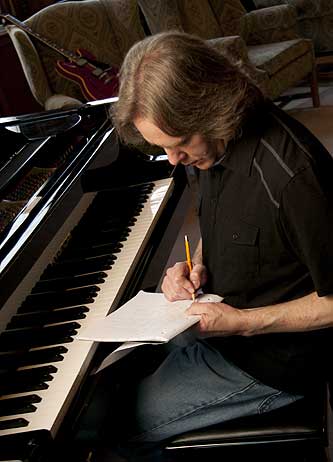 I started
writing songs in the fall of ’08 and started recording in August
’09. We began mixing in the late spring of 2010. I was still
writing and tracking new songs while we were mixing. Typically I would
give Mike a click- tracked demo of guitar or piano, vocal and bass
to play drums over and then bring that home and finish it off. Both
Paul and I use Digital Performer so I was able to do this with little
trouble. Once complete, I would then bring the tracks back to either
Paul or Chris Reba for mixing. Chris is an associate of mine at the
University of New Haven. Chris teaches recording classes and has a
real good ear for mixing. Both guys would give me their input and
based on their suggestions, I would add or make changes. It was very
valuable to have two more creative people involved, as it’s easy
to get too wrapped up into details and miss the big picture. My wife
Carol was very helpful as well in weeding out compromised vocals or
solos. I would also play tracks for my students to confirm I was on
the right track. I was the producer of this project but Paul was so
helpful especially in the early stages that set the feel of the tracks
that I thought he deserved a co-producer credit.
I started
writing songs in the fall of ’08 and started recording in August
’09. We began mixing in the late spring of 2010. I was still
writing and tracking new songs while we were mixing. Typically I would
give Mike a click- tracked demo of guitar or piano, vocal and bass
to play drums over and then bring that home and finish it off. Both
Paul and I use Digital Performer so I was able to do this with little
trouble. Once complete, I would then bring the tracks back to either
Paul or Chris Reba for mixing. Chris is an associate of mine at the
University of New Haven. Chris teaches recording classes and has a
real good ear for mixing. Both guys would give me their input and
based on their suggestions, I would add or make changes. It was very
valuable to have two more creative people involved, as it’s easy
to get too wrapped up into details and miss the big picture. My wife
Carol was very helpful as well in weeding out compromised vocals or
solos. I would also play tracks for my students to confirm I was on
the right track. I was the producer of this project but Paul was so
helpful especially in the early stages that set the feel of the tracks
that I thought he deserved a co-producer credit.
As far as playing most of the instruments, I quite enjoy it. As I
layer each instrument down a sonic picture starts to form, almost
like a painting. I like the option of playing a part, listening to
it in the studio or car for a week and deciding to keep or try again.
I change my mind a lot and it doesn’t cost me anything but my
time. I really like playing bass as I have a Hofner ’63 reissue
Beatle bass that got a good workout. It’s not until you put the
bass down that it feels like a song! Harmony vocals are also fun.
I do much experimentation with that as well.
mwe3: What electric and acoustic guitars do you feature on the 16
Stories album and how would you compare your guitar sound on the
new album with your earlier release?
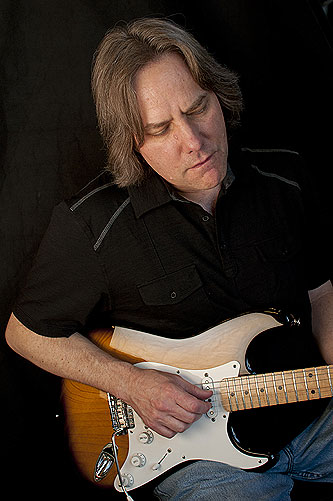 BS: Just
like on Standard Interpretations my Lowden acoustic guitars
were very important. I have an S32J nylon and a S32C steel that I
absolutely love. My mid 70’s Martin D28 also got much play time.
For electrics I have a Jay Black custom shop Stratocaster that saw
much use. Right at the end of tracking I added a nice LE PRS semi
hollow 22 with a whammy bar and the ’59 pickups. That guitar
worked out great for solos. You can hear it in “It All Comes
Back”, “It’s In The Way” and “Goodbye”.
BS: Just
like on Standard Interpretations my Lowden acoustic guitars
were very important. I have an S32J nylon and a S32C steel that I
absolutely love. My mid 70’s Martin D28 also got much play time.
For electrics I have a Jay Black custom shop Stratocaster that saw
much use. Right at the end of tracking I added a nice LE PRS semi
hollow 22 with a whammy bar and the ’59 pickups. That guitar
worked out great for solos. You can hear it in “It All Comes
Back”, “It’s In The Way” and “Goodbye”.
Others used were a ES 335, ES 175, ‘59 LP reissue, G&L ASAT,
LP Junior, and the real star of the show a ’60 ES 330 that I
call my Beatle guitar. It has the best P90’s I have ever heard.
It’s featured in “Believe In” and “Heroes”
One of my students let me borrow his Regal round-neck resonator guitar
for “The Sun Will Shine Tomorrow”. For bass I used a Hofner
’63 reissue and a Fender Jazz bass recorded direct through the
LA610. Paul used a Modulus Jazz bass and I believe Chris used a jazz
bass as well on “Goodbye”. I have three amps, a ’61
Princeton, Dr. Z Maz Jr. and a Fender Pro Reverb. For microphones,
I used a Royer 121 and a SM57 through a UA LA610. As far as comparing
sounds, I used the same amps, guitars and signal chain on both CDs.
Paul and Chris’s mixing styles and the song context could change
the sound perception a bit.
mwe3: How does using different amps and effects help alter the sound
and scope of a track?
BS: For me the sound influences everything. I’m going to play
a different solo on a Strat than I would on a Les Paul or a PRS. It’s
the same with keyboards but not so much with bass. Before I record
I’m usually chasing a sound I hear in my head. That sound will
influence which guitar and amp I choose and then the overall sound
of that will influence what I play. For example when I was writing
“Too Much Information” I started on acoustic piano and was
stuck. As soon as I switched to a patch on the Yamaha Motiff the whole
thing came together right away. Even though there are a couple guitars
in that track, the keys drive it.
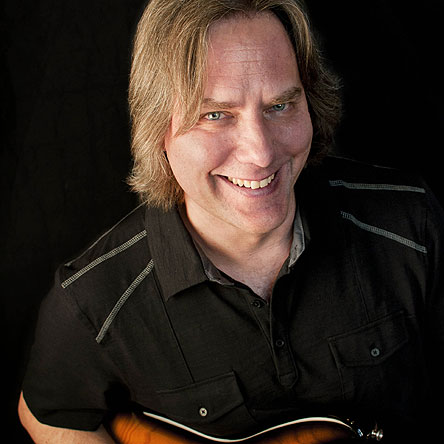 mwe3: Was
there a lot of tweaking and overdubbing on the 16 Stories album?
Can you say something about the overall recording process?
mwe3: Was
there a lot of tweaking and overdubbing on the 16 Stories album?
Can you say something about the overall recording process?
BS: Yes!! There was much tweaking and overdubbing. It took me 2 1/2
years to write and record this. All the while I maintained a full
teaching and performing schedule. I had a sound in my head I wanted
to achieve for each track and wouldn’t quit till I got it. I
know I drove Paul and Chris nuts with details in the mixing. When
I overdub parts I think of the tonal frequency and panning placement
of each part. So I already have a good idea where I want something
to be and how it should sound. For that reason I’m very involved
in the mixing process. I sat in with Paul for each mixing session
and songs got mixed multiple times. Chris Reba did most of his mixing
without me there and would remix until we got it where we wanted it.
Two songs that were particularly troublesome were “The Power
Of Love” and “Heroes”. Those two drove us crazy. I
almost gave up on “The Power of Love” but it came to life
after redoing the lead guitars with the PRS and a borrowed ‘59
LP reissue.
mwe3: Several of the 16 Stories tracks are more low-key while
others in the rock style really soar. How would you compare your fondness
for rock with your jazzy, easy pop style, which seems to be equally
balanced on the 16 Stories album?
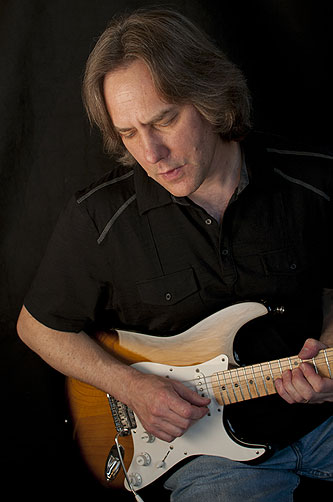 BS: I’m
a big Beatle guy. If you listen to the white album, the song styles
go from acoustic folk to screaming rock. I don’t like it when
I buy a CD and all the songs sound the same. I know that’s exactly
what a big label wants so that it’s an easy sell but I get bored
easy. I also read that McCartney recorded “Yesterday” and
“I’m Down” in the same day. Talk about diversity. That
said I’m not really purposely thinking about being diverse. I
write songs on piano, keys, nylon string, steel string and electric
guitar. Each one of those instruments brings out a different side
of my personality. Also my band and teaching experiences have forced
me to be real versatile in order to make a living so I’m capable
and like playing many different styles.
BS: I’m
a big Beatle guy. If you listen to the white album, the song styles
go from acoustic folk to screaming rock. I don’t like it when
I buy a CD and all the songs sound the same. I know that’s exactly
what a big label wants so that it’s an easy sell but I get bored
easy. I also read that McCartney recorded “Yesterday” and
“I’m Down” in the same day. Talk about diversity. That
said I’m not really purposely thinking about being diverse. I
write songs on piano, keys, nylon string, steel string and electric
guitar. Each one of those instruments brings out a different side
of my personality. Also my band and teaching experiences have forced
me to be real versatile in order to make a living so I’m capable
and like playing many different styles.
mwe3: Who do think will most enjoy your new album and what are you
hoping listeners will derive from listening to 16 Stories?
BS: I think the folks that will like this CD will be the people
that may have given up hope that this type of music doesn’t exist
anymore. If you don’t like what you’ve been hearing on the
radio for the last 20 years, you may like this. If you want to hear
good old school rock guitar playing with thoughtful lyrics you can
relate to, this may be what you’re looking for. And last but
not least, if you tired of hearing angry, negative, screaming music,
this may be your cup of tea. My goal in making music is that it should
make you feel good during and after you hear it. I think with this
CD I’ve accomplished this goal.
mwe3: What are you plans, musical and otherwise for the rest of
2011 and beyond?
BS: My full teaching and performing schedule will continue to keep
me busy. I also have new material to record so another CD may be in
my future plans. For now I’m going to do my best to promote this
project and see where it goes.
Thanks to Bob Semanchik @ www.bobguitar.com



